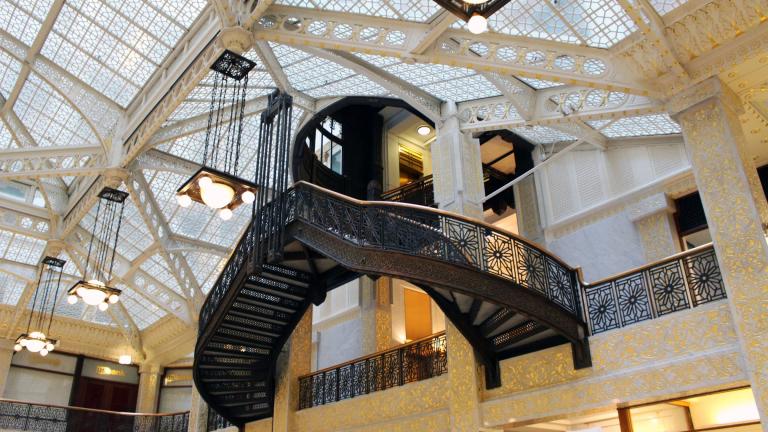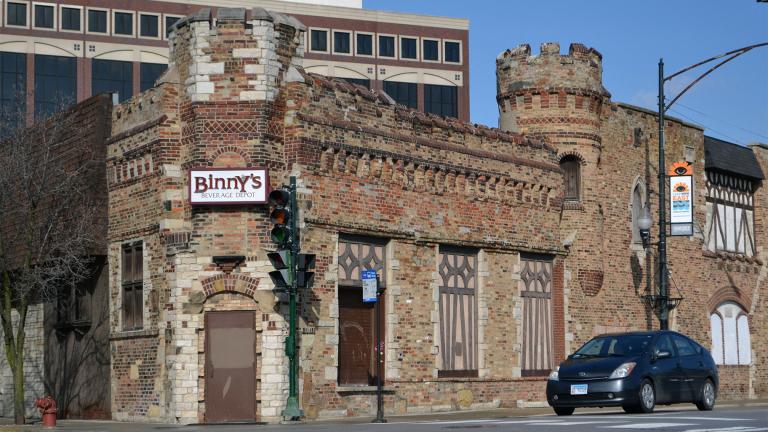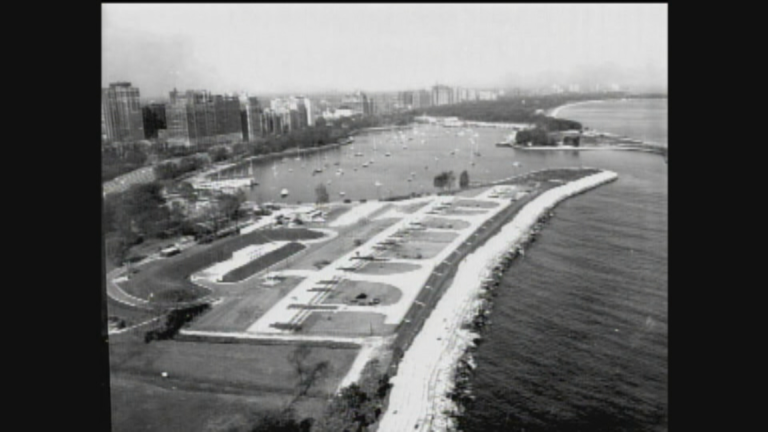Geoffrey Baer deposits some knowledge about buildings left behind by the banking panics of the Great Depression. And he shares the tide-tossed tale of the Dixiana.
What’s the history of the building at California and Belmont that has Immel State Bank inscribed on it? Is there an inheritance waiting there for me?!
– Crystin Immel, “Chicago Tonight” control room
We are sorry to tell “Chicago Tonight” line producer Crystin Immel that she’s going to have to keep coming back to work, since Immel State Bank folded in 1931. Bad news for her, good news for us!
Immel State Bank was one of the thousands of banks across the United States that closed in the banking panics of 1930 and 1931 during the Great Depression. After some large public banks failed, such as the New York Bank of the United States in 1930, fears of other banks failing spread across the country. Ironically, this often actually caused the bank to close. A Hollywood depiction of a bank run was in the holiday classic, “It’s a Wonderful Life,” in which George Bailey explains to panicked customers, “You’re thinking of this place all wrong, as if I had the money back in a safe! The money’s not here. Your money’s in Joe’s house, it’s in Fred’s house, and a hundred others.”

The banking panics inspired the Franklin Delano Roosevelt to say, “The only thing we have to fear is fear itself” in his 1933 inaugural address.
Many banks that closed in 1931 looked like Greek and Roman temples. The grand neo-classical style that made them look steadfast and trustworthy. Many have long since been torn down, but the Immel building is among a few that still stand. After the Immel State Bank closed, the building became the Kelling Nut Company offices, and in 1998, a banquet hall named Michelle’s Ballroom.
A few other banks that closed in 1931 and are still standing include the former Kimbell Trust and Savings in Logan Square, which is today a medical clinic; the terracotta masterpiece Laramie State Bank in the Austin neighborhood, which has been vacant for some years and is now endangered due to deferred maintenance; the Lincoln Trust and Savings Bank in the North Center neighborhood, now a commercial and residential development, as is the former West Town State Bank building at Western and Madison.
Probably the most interesting reuse of a closed bank is the former Noel State Bank building built in 1919 at Milwaukee and North Avenues in Wicker Park. Since 2012 it’s been the world’s fanciest Walgreens, with a coffered ceiling and stained glass skylight. They even re-used the bank’s vault – today, it’s where you can stock up on vitamins.
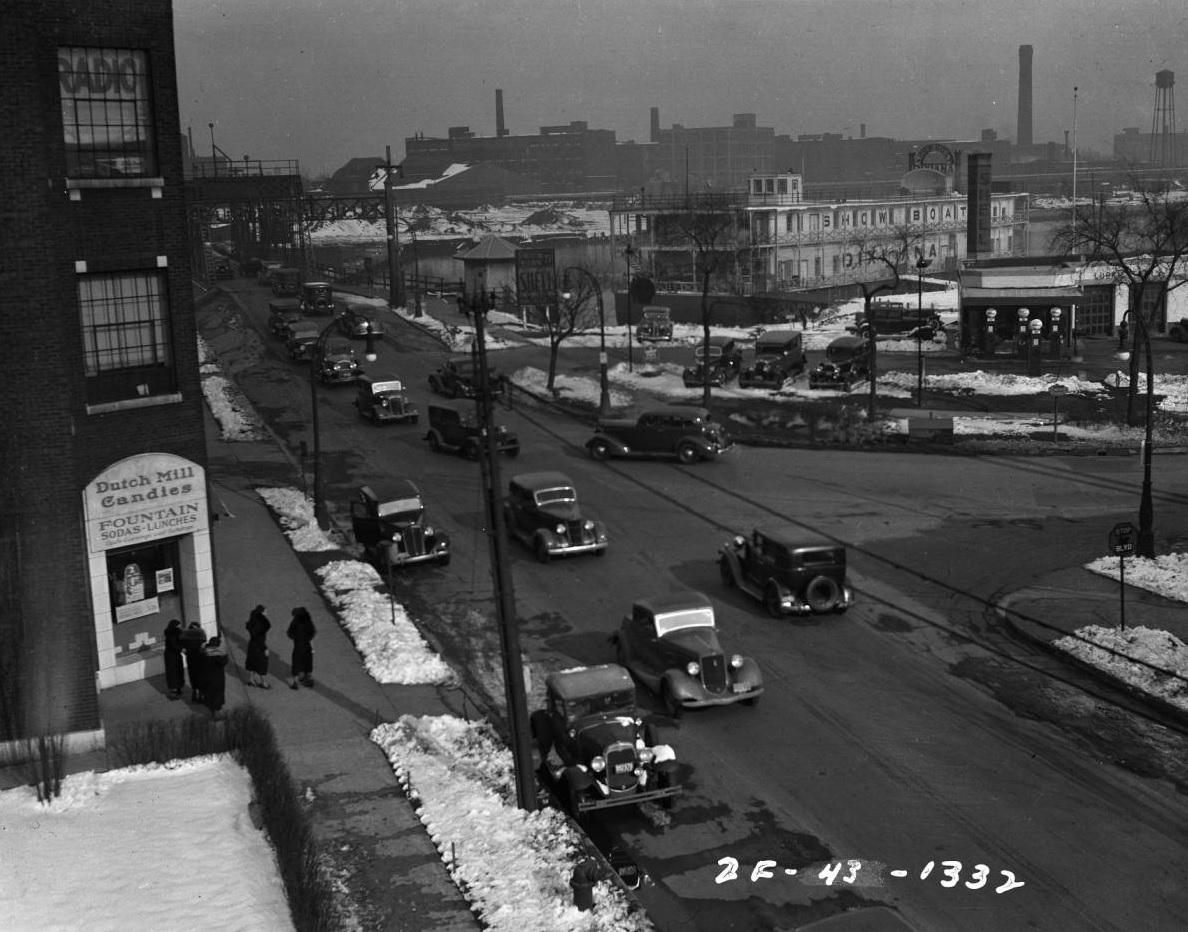
I have a photo of a row of 2-flats around Logan Boulevard and Diversey Avenue by the Chicago River. Another photo also shows the building housing Dutch Mill Candies, and a showboat on the river. Who was the architect of the 2-flats and when were they built?
– Liz Terrones, Logan Square
Unfortunately we weren’t able to identify the architect of the 2-flats, but we do know they were built around 1914, possibly as workers’ housing for industrial businesses in that area, according to Logan Square Preservation’s Andrew Schneider.
But we have to admit we were much more interested in learning about the showboat she mentioned – it’s on the right in the photo. We featured a different showboat in the river closer to downtown a few years ago, but this one was new to us.
The Dixiana was a 200-foot long reproduction of a southern-style showboat built in 1932 in Sturgeon Bay, Wisconsin. Its owners hoped the 1,000-seat showboat would become a mainstay in Chicago staging melodramas, but little did they know they were embarking on their own tide-tossed melodramatic journey.
They ran into trouble right away when Mayor Anton Cermak banned the boat from docking in the Chicago River, saying that the city had enough shuttered theaters and adding a new one on a boat didn’t make sense. Pleas from the public got him to change his mind, and the Dixiana docked in the river between State and Dearborn in October 1933.
But before putting on a single show, the city said it interfered with dumping snow into the river and ordered it moved, so the owners relocated it to a private dock at Diversey, as seen in the picture our viewers sent us and others we found.
After some months-long permitting problems, the Dixiana finally staged their first melodrama, “No Mother to Guide Her,” in August 1934 – nearly a year after arriving in Chicago. A few months later, a member of the acting troupe, Hugh Adams, died of a heart attack on board the boat, postponing the production of a new show.
The show went on, of course, but even though they sold out many shows, it wasn’t enough to keep the business on course, and the owners filed for bankruptcy in just over a year.
The defunct showboat remained at Diversey Avenue until new owners took the show on the road – well, water –a year and a half later. They planned a Great Lakes tour staging “Tobacco Road,” a play that Mayor Edward Kelly banned from Chicago, deriding it as “a mass of outrageous obscenity.” The tour was to begin in Michigan City, Indiana, but after a rough trip across the lake, the boat literally began to burst at the seams upon arrival and half-sank in Michigan City’s harbor, delaying shows until it could be repaired.
The play opened a month later in June 1937, but it ran only a few weeks before a U.S. Naval Reserve boat accidentally rammed it, leaving a gaping hole in the hull. By the time the boat was repaired again, the forlorn cast had bailed out to seek fairer waters in New York. The hole reopened a few months later and the 5-year-old vessel was finally scrapped – but the cursed Dixiana delivered one final blow on its way down. A seaman working on the dismantling, Frank Winters, drowned in the Michigan City harbor when he fell off the gangplank of the very unlucky showboat.
By the way, if you’d like to see more photos of historic Chicago streets like the one in this story, the University of Illinois at Chicago hosts an online collection of 2,300 fascinating images taken by the Illinois Department of Transportation from the 1920s to the 1950s. They capture many of Chicago’s intersections, subways and underpasses, signs, bridges and viaducts, snow removal, pedestrians, and other features of traffic in the city.
More Ask Geoffrey:
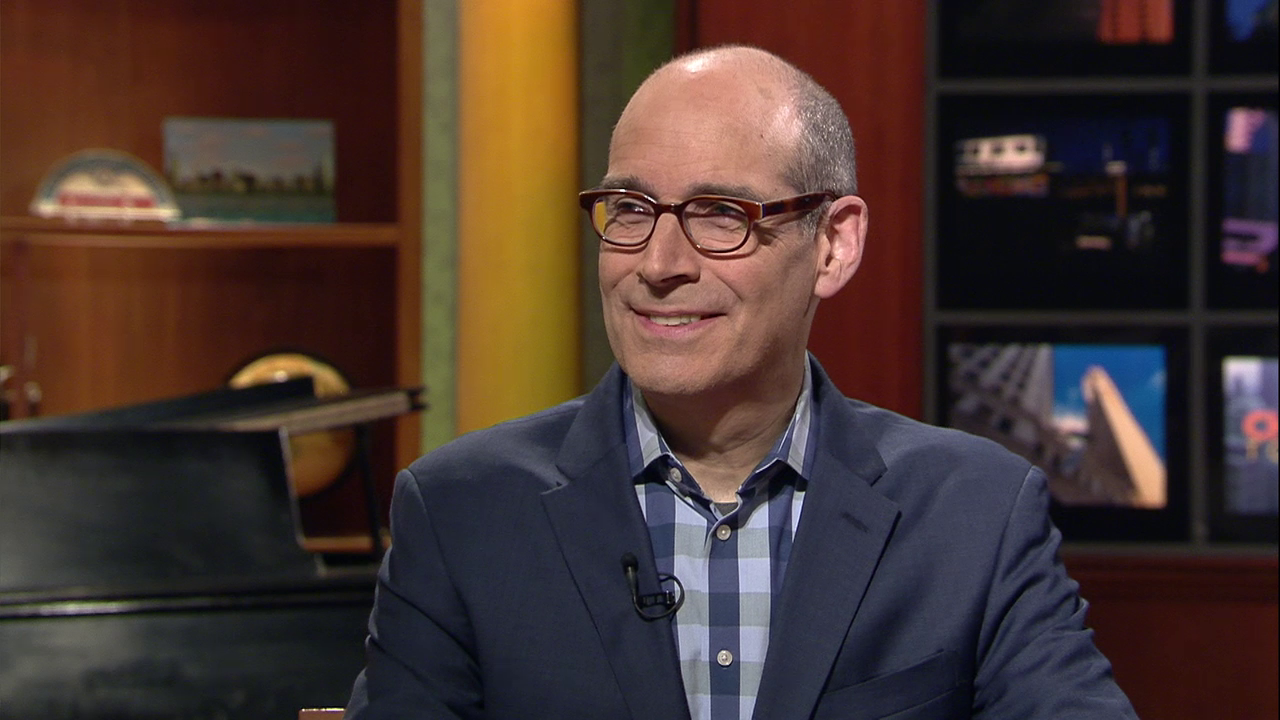 Did you know that you can dig through our Ask Geoffrey archives? Revisit your favorite episodes, discover new secrets about the city's past, and ask Geoffrey your own questions for possible exploration in upcoming episodes. Find it all right here.
Did you know that you can dig through our Ask Geoffrey archives? Revisit your favorite episodes, discover new secrets about the city's past, and ask Geoffrey your own questions for possible exploration in upcoming episodes. Find it all right here.
Do you have a question for Geoffrey? Ask him.



